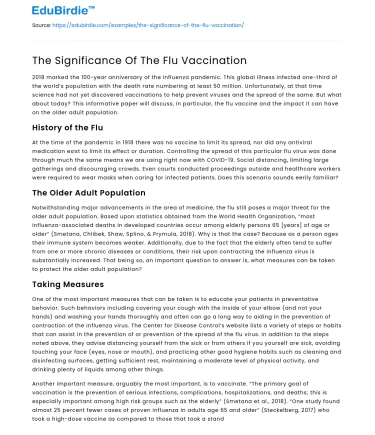2018 marked the 100-year anniversary of the influenza pandemic. This global illness infected one-third of the world’s population with the death rate numbering at least 50 million. Unfortunately, at that time science had not yet discovered vaccinations to help prevent viruses and the spread of the same. But what about today? This informative paper will discuss, in particular, the flu vaccine and the impact it can have on the older adult population.
History of the Flu
At the time of the pandemic in 1918 there was no vaccine to limit its spread, nor did any antiviral medication exist to limit its effect or duration. Controlling the spread of this particular flu virus was done through much the same means we are using right now with COVID-19. Social distancing, limiting large gatherings and discouraging crowds. Even courts conducted proceedings outside and healthcare workers were required to wear masks when caring for infected patients. Does this scenario sounds eerily familiar?
Save your time!
We can take care of your essay
- Proper editing and formatting
- Free revision, title page, and bibliography
- Flexible prices and money-back guarantee
The Older Adult Population
Notwithstanding major advancements in the area of medicine, the flu still poses a major threat for the older adult population. Based upon statistics obtained from the World Health Organization, “most influenza-associated deaths in developed countries occur among elderly persons 65 [years] of age or older” (Smetana, Chlibek, Shaw, Splino, & Prymula, 2018). Why is that the case? Because as a person ages their immune system becomes weaker. Additionally, due to the fact that the elderly often tend to suffer from one or more chronic diseases or conditions, their risk upon contracting the influenza virus is substantially increased. That being so, an important question to answer is, what measures can be taken to protect the older adult population?
Taking Measures
One of the most important measures that can be taken is to educate your patients in preventative behavior. Such behaviors including covering your cough with the inside of your elbow (and not your hands) and washing your hands thoroughly and often can go a long way to aiding in the prevention of contraction of the influenza virus. The Center for Disease Control’s website lists a variety of steps or habits that can assist in the prevention of or prevention of the spread of the flu virus. In addition to the steps noted above, they advise distancing yourself from the sick or from others if you yourself are sick, avoiding touching your face (eyes, nose or mouth), and practicing other good hygiene habits such as cleaning and disinfecting surfaces, getting sufficient rest, maintaining a moderate level of physical activity, and drinking plenty of liquids among other things.
Another important measure, arguably the most important, is to vaccinate. “The primary goal of vaccination is the prevention of serious infections, complications, hospitalizations, and deaths; this is especially important among high risk groups such as the elderly” (Smetana et al., 2018). “One study found almost 25 percent fewer cases of proven influenza in adults age 65 and older” (Steckelberg, 2017) who took a high-dose vaccine as compared to those that took a standard-dose vaccine. Such statistics are enough to cause one to seriously consider the flu vaccine as a preventative measure for the elderly population. Vaccinations also can help prevent ever rising healthcare costs. How so? Think about how easy giving a vaccination is. It literally takes five minutes to give an injection. Now think about how timely, costly, and complicated it is to care for a person who is ill with pneumonia as a result of contracting the flu. Sometimes, however, people just get sick. What then would the next step be?
Most likely an antiviral treatment would be prescribed after one has contracted the flu. Usually when treatment is started within two days of becoming sick with flu symptoms, antiviral drugs can lessen fever and flu symptoms and shorten the time you are sick. They may also reduce the risk of hospitalizations in the older adult. This would be especially beneficial for those over the age of sixty-five as well as those living in nursing homes and long-term care facilities as being at an already “high risk” level.
Conclusion
Though over 100 years have passed since the influenza virus entered the world scene, and despite incredible advances in the field of medicine in the last century, the flu still constitutes a serious issue among the older adult population. As nurses we need to educate the older population on the importance of vaccinations. We need to take practical measures to protect the older adult population. This in turn will help the older adult population to live longer and healthier lives.






 Stuck on your essay?
Stuck on your essay?

